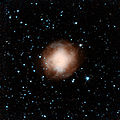| Emission nebula | |
|---|---|
| Planetary nebula | |
 NGC 4361 imaged with a 24-inch telescope | |
| Observation data: J2000 epoch | |
| Right ascension | 12h 24m 30.8s [1] |
| Declination | −18° 47′ 5.6″ [1] |
| Distance | 3,377.2±153.6 [1] ly |
| Apparent magnitude (V) | 10.9 [2] |
| Apparent dimensions (V) | 1.3' x 1.3' [2] |
| Constellation | Corvus [3] |
| Designations | NGC 4361, PN G294.1+43.6 |
NGC 4361 (also known as the Lawn Sprinkler Nebula [4] or Garden Sprinkler Nebula) is a planetary nebula in the Corvus constellation. [3] [1] [2] It is included in the Astronomical League's Herschel 400 Observing Program.

